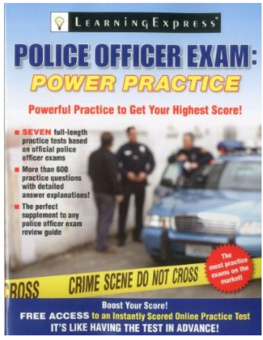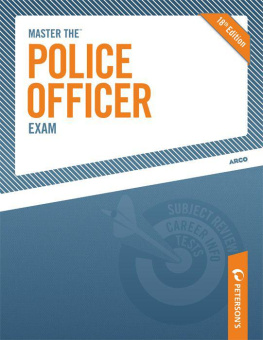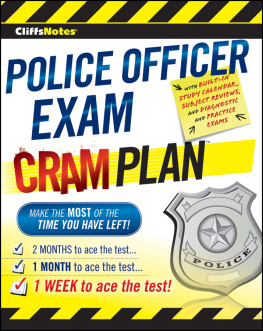

Welcome to Barrons Police Officer Exam, 10th Edition, eBook version!
Please note that depending on which type of device you are using to view this eBook on, illustrations, photos, graphs, tables, equations, etc. will look different than in a print version of the book. Please adjust your device accordingly.
This eBook contains hyperlinks that will bring you to helpful information, navigate through the books content, and allow you to click between practice questions and answers.
Good luck!
Copyright 2017, 2013, 2009, 2005, 2001, 1997, 1992, 1987, 1986, 1982
by Barrons Educational Series, Inc.
Examination No. 5114
Copyright 1986 by the Department of Personnel, City of New York.
Examination No. 4061
Copyright 1984 by the Department of Personnel, City of New York.
All rights reserved.
No part of this work may be reproduced or distributed in any form or by any
means without the written permission of the copyright owner.
Note that any resemblance of descriptions to people living or dead, or incidents past or present, is coincidental.
All inquiries should be addressed to:
Barrons Educational Series, Inc.
250 Wireless Boulevard
Hauppauge, New York 11788
www.barronseduc.com
eISBN: 978-1-4380-6882-4
First eBook publication: May 2017
Contents


S ince the first edition of Police Officer Exam was published, hundreds of thousands of police candidates have used it to prepare for police officer examinations throughout the country. In addition we, along with others, have used this Barrons book exclusively and with great success in various courses given to help prepare candidates to take the entrance examination for both large and small police departments. Feedback from police candidates all over the country indicates that so much of the success they have experienced in taking police entrance examinations is directly attributable to this book. But you, the candidate, must understand that, while this book can be the vehicle that can help you earn your gun and shield, unless you make the required necessary effort to study and learn its contents, you are cheating yourself.
Just about every police department requires that a newly hired employee interested in working his or her way up the ladder must begin at the very bottom of the organization. We did just that and quickly ascended the civil service ranks of the New York City Police Department. This book contains many of the successful strategies we developed during our study for police examinations. However, we would like to share with you something else we learned that cannot be disputed: SUCCESS IN THE WORLD OF CIVIL SERVICE TESTS REQUIRES DEDICATION AND HARD WORK. If you are willing to pay that price, we are confident that this text can help you and you will be successful. Good luck!
Donald J. Schroeder
Frank A. Lombardo
Our thanks to the New York City Police Department for permission to reprint the Patrol Guide material, the Legal Division bulletins, the Department forms, and the Operations orders used throughout this publication. Our thanks, also, to the New York City Department of Personnel for permission to reprint official New York City Police Department Examinations.


 THE POLICE OFFICER EXAM
THE POLICE OFFICER EXAM
 THE POLICE OFFICERS JOB
THE POLICE OFFICERS JOB
 HOW TO BECOME A POLICE OFFICER
HOW TO BECOME A POLICE OFFICER
 HOW TO APPLY FOR THE EXAM
HOW TO APPLY FOR THE EXAM
T he type of examination that is administered throughout the country to select qualified men and women for careers in the police field has been greatly modified over the past few years. As a result of a Supreme Court decision a number of years ago, test writers are not permitted to use certain kinds of questions. For example, questions cannot be asked which require prior knowledge of the law, police procedures, or the duties and responsibilities of a police officer. You are not required to know what a police officer is to do under certain circumstances such as if he or she arrives at the scene of a robbery. That is the kind of knowledge you acquire after you are admitted to a police academy.
The procedures and questions used in this book were written after a continuous and careful analysis of recent major police officer examinations and all court cases dealing with police entrance level examinations. This chapter will serve to familiarize you with the contents of this manual so that you will be able to fully utilize it in preparing for the exam. By using this book properly, you will be prepared to take, and successfully complete, the most recent types of entry level police officer examinations.
You are planning to take the Police Officer Examination because you have decided to join the police force. Therefore, it seems only fitting to provide an overall view of the types of positions available and the compensation that can be expected.
As you probably already know, the basic mission of the police is to protect life and property, to find and arrest criminal offenders, to preserve the peace, to enforce laws, and to prevent and detect crime. The basic mission is the same for all police officers regardless of whether the department involved is a city, county, state, or federal agency. The difference between police departments is one of degree of work and not kind of work. In other words, all police agencies perform the same kind of work and differ only in the amount of work they perform in each area of the basic mission. Also, in both large and small police departments, the activities of the police are divided into both line and staff duties. Line duties concern those jobs which directly deal with accomplishing the basic mission. Staff duties are jobs which help and support line duties.
Types of Police Positions
LINE POSITIONS
Patrol
In this position, uniformed police officers patrol through the community by foot, scooter, motorcycle, automobile, and sometimes by boat or plane. Responsible for a beat, post, or sector, which is an assigned, fixed geographical area, the police officer spends much time answering a wide variety of calls for assistance from the public.
Traffic
An often difficult job, police officers working in uniform on traffic duty prevent vehicular accidents and congestion by issuing summonses, directing traffic, and investigating traffic accidents.
Detectives
Working in business attire, detectives, the investigators of the police department, are called to the scene after a major crime has been committed. They follow investigatory leads and attempt to identify and arrest persons responsible for past criminal acts.
Next page








 THE POLICE OFFICER EXAM
THE POLICE OFFICER EXAM